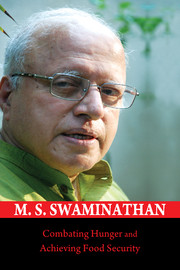Book contents
- Frontmatter
- Contents
- Foreword
- Preface
- Acknowledgements
- Abbreviations
- 1 Genesis and Growth of the Yield Revolution in Wheat
- 2 Our Agricultural Heritage
- 3 Shaping Our Agricultural Destiny
- 4 Thrust on Farm Revival
- 5 Nutri-farm Movement
- 6 Nutrition-sensitive Agriculture
- 7 Food Losses and Food Waste
- 8 Rice in Zero Hunger Challenge
- 9 Monsoon Management
- 10 Importance of Ecological Conservation
- 11 Caring for Ecology and Heritage
- 12 Conserving Biodiversity
- 13 Overcoming Hidden Hunger through Aquaculture
- 14 Biofuels – The Way to Go
- 15 Food Security
- 16 Vigilance for Sustainable Food Security
- 17 Food Security and Social Protection
- 18 Food Security and its Role
- 19 Sustaining the Livestock Revolution
- 20 Challenges in the Year of Science
- 21 Agriculture and Humanism
- 22 Fostering the Science of Science Communication
- 23 Olympic Move for Saving Children
- 24 Youth: The Agents of Change
- 25 Role of Women in Agricultural Production
- 26 Know-how to Do-how
- 27 From Bengal Famine to Right to Food
- 28 Financial Institutions and Fighting Food Inflation
- 29 Public Good Research in Agriculture
- 30 The Future of Indian Agriculture
- Bibliography
27 - From Bengal Famine to Right to Food
Published online by Cambridge University Press: 18 December 2015
- Frontmatter
- Contents
- Foreword
- Preface
- Acknowledgements
- Abbreviations
- 1 Genesis and Growth of the Yield Revolution in Wheat
- 2 Our Agricultural Heritage
- 3 Shaping Our Agricultural Destiny
- 4 Thrust on Farm Revival
- 5 Nutri-farm Movement
- 6 Nutrition-sensitive Agriculture
- 7 Food Losses and Food Waste
- 8 Rice in Zero Hunger Challenge
- 9 Monsoon Management
- 10 Importance of Ecological Conservation
- 11 Caring for Ecology and Heritage
- 12 Conserving Biodiversity
- 13 Overcoming Hidden Hunger through Aquaculture
- 14 Biofuels – The Way to Go
- 15 Food Security
- 16 Vigilance for Sustainable Food Security
- 17 Food Security and Social Protection
- 18 Food Security and its Role
- 19 Sustaining the Livestock Revolution
- 20 Challenges in the Year of Science
- 21 Agriculture and Humanism
- 22 Fostering the Science of Science Communication
- 23 Olympic Move for Saving Children
- 24 Youth: The Agents of Change
- 25 Role of Women in Agricultural Production
- 26 Know-how to Do-how
- 27 From Bengal Famine to Right to Food
- 28 Financial Institutions and Fighting Food Inflation
- 29 Public Good Research in Agriculture
- 30 The Future of Indian Agriculture
- Bibliography
Summary
2013 marks the seventeith anniversary of the Bengal Famine, which resulted in the death of an estimated 1.5 to 3 million children, women and men during 1942–43. A plethora of factors led to this mega tragedy: the Japanese occupation of Burma, the damage to the aman (kharif) rice crop both due to tidal waves and a disease epidemic caused by the fungus helminthosporiumoryzae, panic purchase and hoarding by the rich, failure of governance particularly in relation to the equitable distribution of the available food-grains, disruption of communication due to World War II, and the indifference of the then United Kingdom (UK) Government to the plight of the starving people of undivided Bengal.
Famines were frequent in colonial India and some estimates indicate that 30 to 40 million died out of starvation in Tamil Nadu, Bihar and Bengal during the latter half of the nineteenth century. This led to the formulation of elaborate famine codes by the colonial government, indicating the relief measures that should be put in place when crops failed.
The Bengal Famine attracted much attention both among the media and the public, since it occurred soon after Mahatma Gandhi's ‘Quit India’ call to the British in 1942. Agricultural stagnation and famines were regarded among the major adverse consequences of colonial rule. I wish to narrate the impact of the twin developments, namely, the Bengal Famine on the one hand, and the ‘Quit India’ movement on the other, on the minds of students like me. I was studying at the University College, Thiruvananthapuram during 1940–44, when gruesome pictures of starving children, women and men in the streets of Calcutta (now Kolkata) and in the other parts of Bengal appeared in The Hindu, The Statesman and other newspapers. The goal of my university education was to get into a medical college and equip myself to run a hospital in Kumbakonam left behind by my father, M. K. Sambasivan, who had died at a young age in 1936.
Unlike today, when students have to search hard for role models, those of my time had many leaders like Mahatma Gandhi, Jawaharlal Nehru and Subhash Chandra Bose who were worshipped. A few of my college mates and I used to meet to discuss the role we can play when the British quit India. During my BSc biology course, I fell in love with the science of genetics.
- Type
- Chapter
- Information
- Combating Hunger and Achieving Food Security , pp. 145 - 150Publisher: Cambridge University PressPrint publication year: 2016



